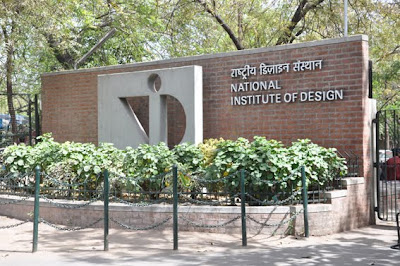






Bamboo is increasingly becoming a material of choice in design practices and across the whole range of scales (product to Architecture) due to its environmental and sustainable qualities. It is fast growing, environmentally sound, available on a whole range of scales from large diameter, tall, structurally strong 'tubes' to fine woven panels for buildings, as well as all manner of domestic items from baskets and cooking utensils to mats, its even being spun and woven into fibres to make blankets and towels. Both NID and CEE are involved in design, economic and social projects exploring further ideas and possibilities for this versatile material.

Along with Barney and Steve Dixon I went on to visit Neelima Hasija Associate Senior Designer- Industrial Design & Coordinator for the Ceramic and Glass Discipline at the National Institute of Design.

NID is a leading design college in India, It was established in 1961 by the Governement of India under the Ministry for Industry as an autonomous leading national institution for design education, training, service and research. The school follows the teaching principles of the Bauhaus and Ulm Schools of Design in Germany and the college has an international reputation as a leading light in the field of design and as a catalyst for change in Indian design, industry and the countries economic development.
"During the early years of post independence India, manifold changes were taking place in economic and social scenario and in production processes with the introduction of new technologies even in the remotest corners of the Indian sub-continent. There were at that time, great thinkers who realized that the process of development demanded a closer look at the future policies and resources that would later on determine the pattern and pace of growth envisioned for India of the future. The Industrial Policy Resolution of 1953 outlined these concerns and indicated broad guidelines. It was as result of these activities that the Government of India invited the renowned design team of Charles and Ray Eames to recommend a programme of design to serve as an aid to the newly established small industries in India. On the basis of their ground breaking and insightful document, 'The India Report', the Government of India set up the National Institute of Design in 1961 as an autonomous national institution for research, service and training in Industrial Design and Visual Communication."

Students from around the world come to study here and both the students projects and staff research includes field work, studying and documenting the indigenous crafts of India.
 The college has a shop which sells work produced by current and recent graduates as well as publications and work by staff. I picked up a great book 'Bamboo and Cane Crafts of North East India' By MP Ranjan documenting the use of cane and bamboo across different states and on different scales from fish baskets to architectural work.
The college has a shop which sells work produced by current and recent graduates as well as publications and work by staff. I picked up a great book 'Bamboo and Cane Crafts of North East India' By MP Ranjan documenting the use of cane and bamboo across different states and on different scales from fish baskets to architectural work.Outside the shop I was introduced to Manish Vaidya the buyer and retail manager of the Craft Centre at the House of MG. He kindly offered to meet and show me some of the workshops in the Old City.
On the way back to Arts Reverie we passed a cycle rickshaw with a giant plastic water storage tank.





